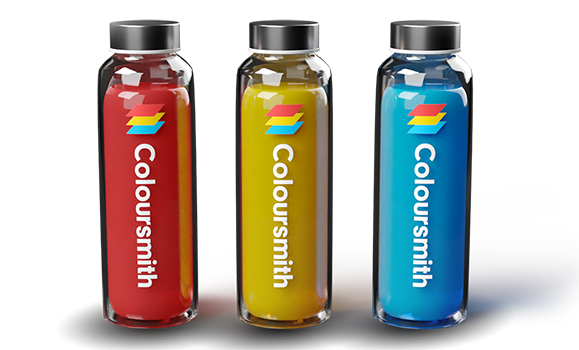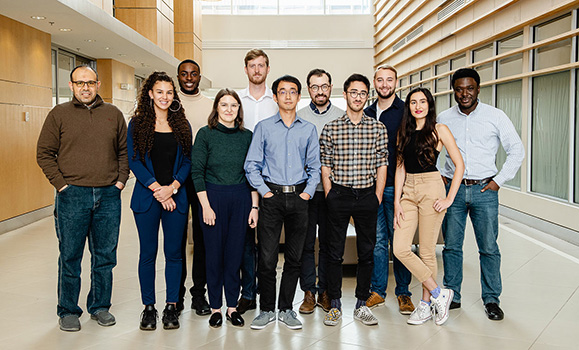The Snapshot
Halifax-based leveraged support from , the Dalhousie-based arm of the global startup program, and is now working with the vision care industry to commercialize its technology that helps colourblind people see colour more vividly.
The Idea
 The first glimpse of the idea behind Coloursmith was spied by Gabrielle Masone, the companyŌĆÖs CEO, during a business validation course she took while studying chemistry at Dalhousie. The alumnus examined the technologies available to people with colour blindness, which affects one in 12 men and one in 200 women. She saw an opportunity to expand their options to include contact lenses.
The first glimpse of the idea behind Coloursmith was spied by Gabrielle Masone, the companyŌĆÖs CEO, during a business validation course she took while studying chemistry at Dalhousie. The alumnus examined the technologies available to people with colour blindness, which affects one in 12 men and one in 200 women. She saw an opportunity to expand their options to include contact lenses.
Shown left Gabrielle Masone, CEO, Coloursmith. (Aaron McKenzie Fraser photo)
She experienced a revelatory moment after presenting her chemistry-based concept at a Dalhousie pitch competition, where she received a positive response from potential supporters and investors.
ŌĆ£I got a lot of interest from different entrepreneurial support organizations, like National Research Council Canada and Atlantic Canada Opportunities Agency, recognizing that, 'Hey, this is pretty compelling,'ŌĆØ Masone recalls. Buoyed by the reaction, she founded Coloursmith shortly after and began pursuing her solution to the problem.
The Challenge
ItŌĆÖs easy for those with normal vision to overlook the impact of colourblindness. Many important signals ŌĆō streetlights being the most obvious ŌĆō are delivered using colour. ŌĆ£Our world is very color based,ŌĆØ Masone explains. ŌĆ£If you have difficulty interpreting or differentiating those colours then you're missing a lot of visual cues. So, colourblindness is very impactful in everyday life. It makes it difficult to do certain activities.ŌĆØ
Traditionally, sunglasses with special light-filtering lenses are used to correct the issue. Sunglasses, however, have functional limitations. ŌĆ£You can't wear sunglasses indoors, in class, on dates,ŌĆØ Masone notes.
She realized that there was an opportunity for Coloursmith if the company could apply the existing light-filtering and colour-enhancing technology to contact lenses, which she says hadnŌĆÖt yet been done because lens manufacturers struggled to incorporate light-filtering ingredients.
 Vials of Coloursmith's ingredients prior to being formulated into contact lens products. (Submitted photo)
Vials of Coloursmith's ingredients prior to being formulated into contact lens products. (Submitted photo)
ŌĆ£So, the company started off with a very simple question: Why donŌĆÖt these products currently exist on the market? We wanted to identify the chemical explanation as to why these things weren't already incorporated into the existing technology, and to propose a solution for that problem,ŌĆØ Masone explains. ŌĆ£It was very much a chemical challenge.ŌĆØ
However, that phase of intensive R&D and ŌĆ£aggressiveŌĆØ patenting of ColoursmithŌĆÖs ideas required funding. Masone found her initial investors while taking part in , which is housed at Dalhousie.
ŌĆ£As a company founder participating in CDL, you're receiving insight and guidance from some of the region's top technical and business minds,ŌĆØ she says. ŌĆ£ItŌĆÖs also a rare chance to spotlight the region's most attractive early-stage investment opportunities. With that dynamic in place, it allows for the development of long-term professional relationships that are highly beneficial to a founder straight out of university.ŌĆØ
The fledgling startup also needed to squeeze the most R&D possible from those fundraising dollars. On that front it was aided by ŌĆÖs , which helps startups move from a minimum viable product to commercialization. Coloursmith received much-needed engineering and 3D modeling resources ŌĆō equipment that was essential for the companyŌĆÖs R&D efforts.
The Solution
From that R&D process, Coloursmith developed proprietary encapsulation technology that add performance-enhancing elements ŌĆō such as light-filtering ingredients ŌĆō to contact lenses. The tech boosts UV protection, enhances colour definition, and allows contact lens manufacturers full control of the light permissibility through the lenses.

ŌĆ£Our encapsulation technology makes the ingredients biocompatible so it can stay within the contact lens material,ŌĆØ Masone notes. ŌĆ£A contact lens is very similar to a sponge. It's permeable. It's porous. What goes in will come out. So, if you put material into a contact that doesn't bind permanently, it'll eventually come out into your eye. You obviously don't want that.ŌĆØ
ColoursmithŌĆÖs technology takes those materials and wraps them in a microscopic, proprietary shell. In the case of dyes, they maintain their light-filtering properties without harming or leaching from the contact lens.
ŌĆ£We're working with a variety of companies in the vision care industry to collaborate on the co-development of new products using this technology,ŌĆØ Masone says. ŌĆ£We have a whole pipeline of products that we hope to see on the market in the next couple of years.ŌĆØ
The Impact
The immediate strategy is to apply ColoursmithŌĆÖs technology to as many applications in the vision-care sector as possible. ŌĆ£The ultimate goal of the technology is to give people improved color vision functionality,ŌĆØ Masone notes.
But she also sees applications for the companyŌĆÖs encapsulation technology beyond vision care, including in the cosmetics industry, where she points to sunscreen as a target.
ŌĆ£It's about tweaking our encapsulation technology so we can do the same thing in other areas: enabling new, beneficial materials to be used in these products where normally they can't easily be used.ŌĆØ

The Coloursmith team at The Labs, an Invest Nova Scotia facility where the company is located. (Aaron McKenzie Fraser photo)
She views her 10-person company more as a platform, licencing its technology across sectors, all while maintaining its base ŌĆö and perhaps its own manufacturing ŌĆö in Nova Scotia.
ŌĆ£We're trying to build the company here in a way that brings new jobs and opportunities to the region, and really links us into the greater vision care industry, which is a $120-billion global industry. It would be really impactful to bring some of that to Nova Scotia.ŌĆØ

